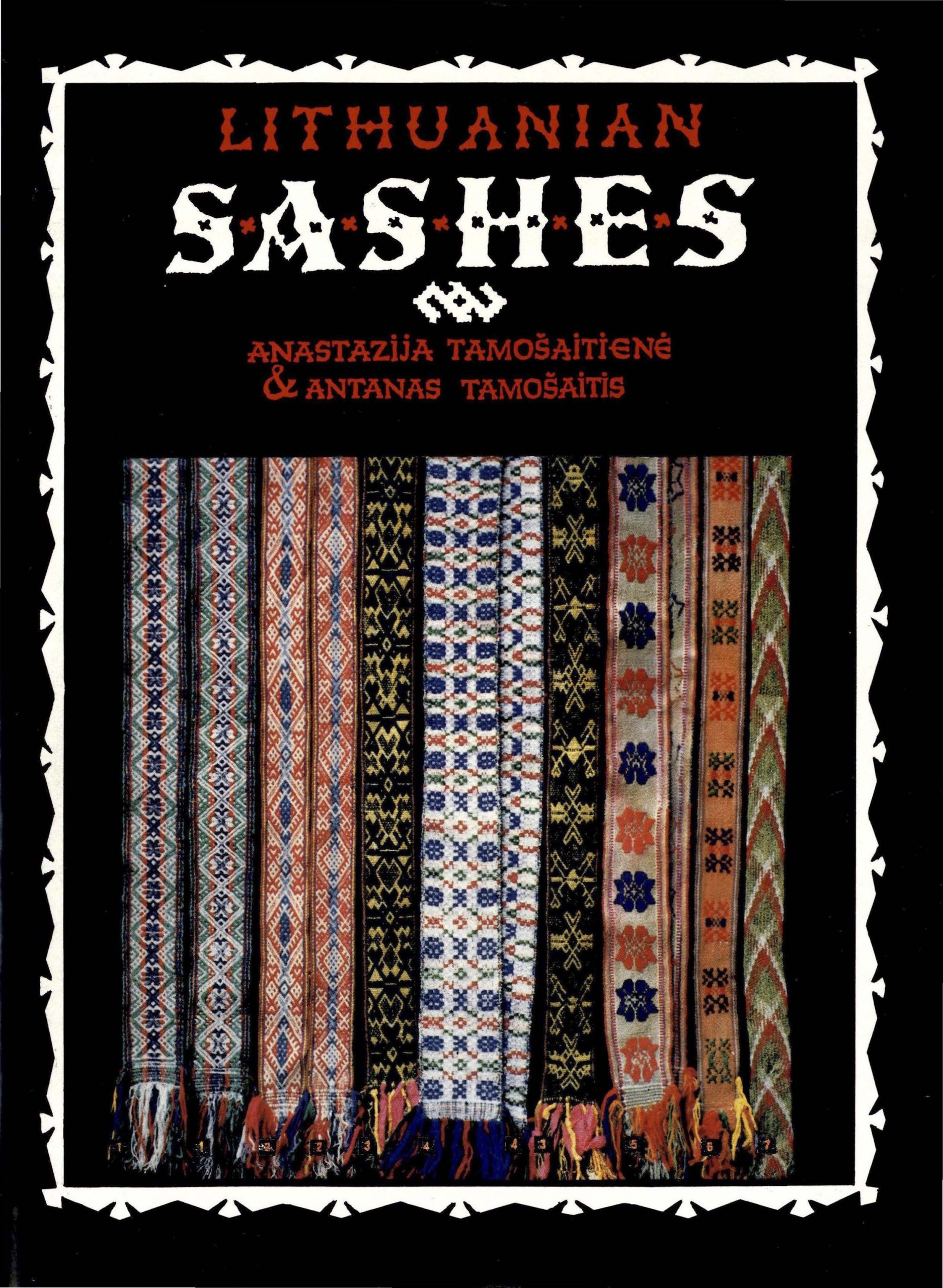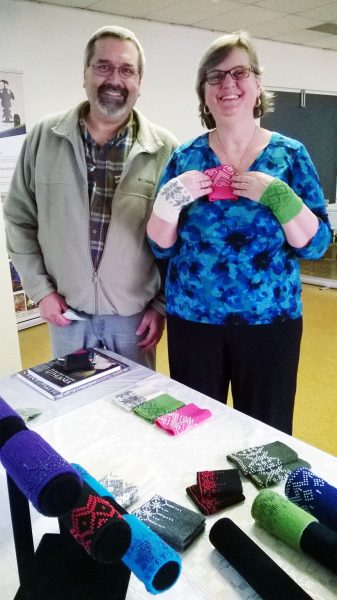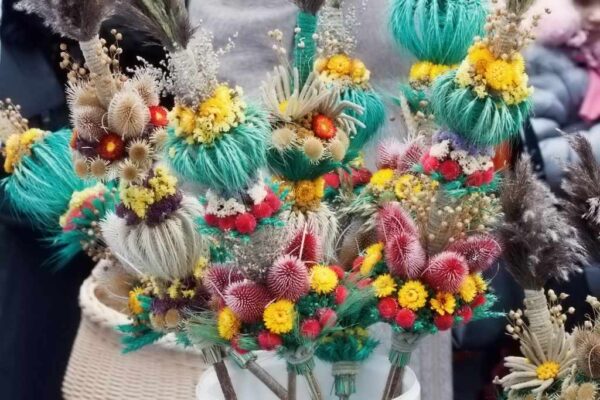Lithuanian Sashes eBook
Free excerpt downloads (JPG) for non-members.
Become a member to receive the full eBook version.

Free excerpt downloads (JPG) for non-members.
Become a member to receive the full eBook version.
This book is the most comprehensive resource on Lithuanian sashes available in English, with history, patterns and techniques, many colour plates, and illustrations of ornaments, motifs and symbols. Part Two of the book by Anastazija Tamošaitienė specifically explains and illustrates traditional Lithuanian sash-making techniques.
Sashes Cover
Sashes Table of Contents
Sashes Examples 1
Sashes Examples 2
Sashes Examples 3
Sashes Examples 4
Sashes Examples 5
Sashes Examples 6
Tamošaitis, Antanas and Anastazija, Lithuanian Sashes. Toronto: Danaitis Associates Inc., 1988 (316 pages: 60 pages of text in English, black and white photos, 47 pages of full colour photos, over 100 coloured diagrams)
This is a very amazing and exciting book which is valuable both as a look back into history, as well as a new source of inspiration to anyone currently weaving. It has been out of print for decades. While ethnographic references such as this one are most likely to be found in the native language of the country, this one is written in English. In preparation for the book, the authors examined several thousand ancient sashes. About one thousand of these have been reproduced in the book. Many of them are in full-color illustrations, photos, sketches, and graphic patterns.
Review by: Annie MacHale
The first part, Traditions of Lithuanian Sashes, is a great resource to anyone interested in folk art, weaving, textiles, or Lithuanian culture and tradition. It outlines the history, uses, and cultural significance associated with various kinds of sashes. Regional differences and similarities are mentioned. A detailed map allows the reader to locate villages and
regions.
The second part, Traditional Lithuanian Techniques for Making Sashes, illustrates tools, materials and techniques. The wide variety of techniques is surprising. They include: plain warp-faced weaving, rep weave, pickup, weft-faced, twill, finger weaving, braiding, plaiting, inlaid, overlaid, tablet weaving, overshot, sprang, knitting, and crochet. Some threading drafts are given for woven bands.
The authors bring to life the culture through stories such as this: “Farmers would bring grain to a mill in colourful, striped sacks which they would immediately recognize upon their return to pick up the flour. Those who did not have such distinctively coloured sacks would tie a colorful patterned sash around their sacks”. They also share verses from folk songs and poetry, some of which are shown as inscriptions woven into bands. The 6-page glossary is very informative and the index helps the reader to easily find what they are interested in.
As a weaver, myself, I discovered a technique that I have never seen used before in warp-faced bands. These bands are illustrated in several photos and described in this way: “Sashes woven with three-coloured motifs were usually woven from handspun wool yarn by the women of the province of Zanavykija. Only three percent of sashes was woven with three-coloured motifs because only the rare weaver had the skill to weave them.” This discovery led to an adventurous hands-on exploration of what type of patterns worked in this technique. The resulting samples were shared in my own book, Three-Colored Pickup for Inkle Weavers.
 An artisan specializing in knitting. She taught a knitting workshop at the LTFAI AGM several years ago and fell in love with the organization. Not only is she a prolific author of knitting books, with “The Art of Lithuanian Knitting” under her belt, but she’s also the creative genius behind our social media presence.
An artisan specializing in knitting. She taught a knitting workshop at the LTFAI AGM several years ago and fell in love with the organization. Not only is she a prolific author of knitting books, with “The Art of Lithuanian Knitting” under her belt, but she’s also the creative genius behind our social media presence.
Donna weaves her magic into our online world, managing the LTFAI Facebook page with finesse. Donna has also enlightened us with her workshops and riveting LTFAI Talks.
 Traditional Crosses in Lithuania:
Traditional Crosses in Lithuania:
Lithuania is sometimes called the land of crosses. Crosses and unique pillar shrines with various sculptures have been an integral part of the Lithuanian landscape for several hundred years. They represent not only religious symbolism but national identity especially in times of repression. We will look at and discuss the amazing wooden carving and iron work of this important folk art and touch on the well known Kryziu Kalnas (Hill of Crosses) site in Lithuania.

Wool (Vilna):
Wool Crafts in Lithuania: Although linen features prominently in Lithuanian folktales and folk songs, we rarely hear about wool. However in the cold climate working with wool was an integral part of daily life forrural villagers in Lithuania. Small farms were self-sufficient; little or no money was needed to supplement the household’s home production. All the women and girls in a family spun, wove, knitted, and felted wool to create all of the households woolens.
 Easter Palms (Verbos)
Easter Palms (Verbos)
History and Significance of Verbos in Lithuanian Life: Palm Sunday is an important part of the Easter tradition. Learn about the history of decorated palms and get to know the customs and decorative techniques specific to Lithuania. (Please note, this is not a hands-on workshop.)
 Black Ceramics (Juoda Keramica)
Black Ceramics (Juoda Keramica)
History and use of black ceramics in Lithuania: The tradition of black ceramics has been documented in Lithuania for centuries. Although eventually falling out of favour due to other pottery techniques, Lithuania is one of the few places that still make this beautiful pottery. Learn about the history, techniques and artistry of black ceramics.
Amber (Gintaras)
Gintaras – Our Golden Heritage: Gintaras, or Amber, has been important to Lithuanians and Baltic people for millennia. Important in terms of culture, art and symbolism. Learn about various aspects of Amber to bring you to a new and better understanding and appreciation of this beautiful “golden stone”.
 Easter Eggs (Marguciai)
Easter Eggs (Marguciai)
History and Significance of Easter Eggs in Lithuanian Life: The egg has long been seen as a symbol of fertility and life. Learn about the role of decorated eggs in ancient and modern times. Get to know the customs and decorative techniques specific to Lithuania.
 We are excited to launch our online LTFAI Talks. We hope to have a series of talks on topics that are relevant to Lithuanian folk art. These are lectures, not workshops, that will provide interesting information for anyone interested in folk art.
We are excited to launch our online LTFAI Talks. We hope to have a series of talks on topics that are relevant to Lithuanian folk art. These are lectures, not workshops, that will provide interesting information for anyone interested in folk art.
They will be from a half hour to a full hour in length with time for discussion at the end.
Each LTFAI Talk is free but you have to register to get an invitation to the session.
 Raised in the Lithuanian community in Hamilton, Ontario. He moved to Winnipeg, Manitoba, to attend university and was a long-time board member of the Lithuanian Canadian Community there and now serves as the resource person for inquiries about the Lithuanians in Manitoba. Giles has over 30 years of experience in municipal heritage conservation planning and public outreach, having retired as the City of Winnipeg’s Senior Planner for Heritage. He is also a current member of the LTFAI Board.
Raised in the Lithuanian community in Hamilton, Ontario. He moved to Winnipeg, Manitoba, to attend university and was a long-time board member of the Lithuanian Canadian Community there and now serves as the resource person for inquiries about the Lithuanians in Manitoba. Giles has over 30 years of experience in municipal heritage conservation planning and public outreach, having retired as the City of Winnipeg’s Senior Planner for Heritage. He is also a current member of the LTFAI Board.
 Ramune is a translator and editor, who worked with the Canadian Lithuanian Weekly Tėviškės žiburiai as managing editor for over 20 years.
Ramune is a translator and editor, who worked with the Canadian Lithuanian Weekly Tėviškės žiburiai as managing editor for over 20 years.
She is also an artisan who makes mosaics and jewellery using Lithuanian motifs and amber. She is a long time member of LTFAI and has recently served on our board. She learned tapestry-weaving from Aldona Vaitonienė, a master weaver in Toronto, Canada.
Testimonials: My first ever tapestry. I am an artist so I did a little extra with the beads and wire cord to hang. It reminds me of a dress so I had fun with that thought. 😉
I think you did an excellent job with the workshop, especially for those of us with no experience weaving. I have already ordered yarn. The colors in this piece was whatever my friend gave me as I was not able to go out shopping.
Newsletters will include events, online events, crafting classes, and talks about Lithuanian heritage topics.
To take full advantage of our events, become a member for only $20.00 (USD) / $15.00 (CAD) a year.
Emails are sent monthly.